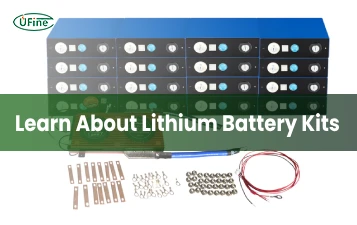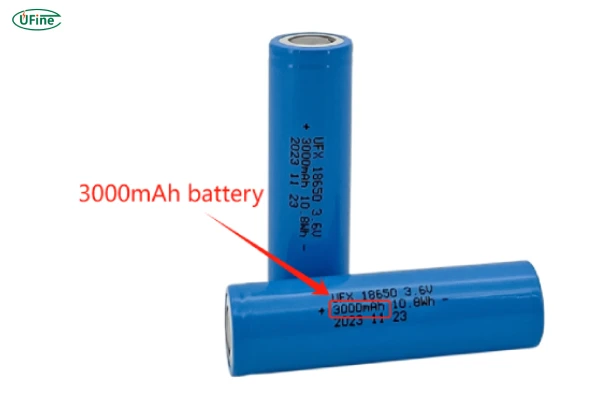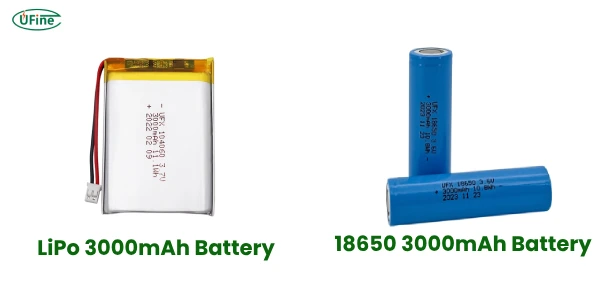Part 1. What does a 3000mAh battery really mean?
When we talk about a 3000mAh battery, we’re referring to its energy storage capacity. But what does this number actually mean in real-world usage?
-
mAh (milliampere-hour) measures how much charge a battery can deliver over time.
-
A 3000mAh battery can theoretically supply 3000mA for 1 hour, 1500mA for 2 hours, or 500mA for 6 hours.
However, real-world performance depends on factors like:
✔ Battery chemistry (Li-ion vs. LiPo vs. LiFePO4)
✔ Discharge rate (higher drain = shorter runtime)
✔ Temperature conditions (cold reduces efficiency)
Key Insight:
While mAh gives a general idea of capacity, it’s not the only factor determining battery life. A high-quality 3000mAh LiFePO4 battery from Ufine Battery, for example, will outperform a cheap lithium-ion cell in both lifespan and stability.
Part 2. Converting 3000mAh to Watts
Many consumers confuse mAh (capacity) with watts (power). Here’s how they relate:
-
Watt-hours (Wh) = Voltage (V) × Amp-hours (Ah)
-
Most 3000mAh lithium batteries operate at 3.7V (standard for Li-ion/LiPo)
-
Calculation: 3.7V × 3.0Ah = 11.1Wh
Why This Matters:
-
Devices are often rated in watts, not mAh.
-
A 3000mAh battery can theoretically power an 11.1W device for 1 hour.
-
For solar applications, knowing watt-hours helps size battery banks correctly.
Conversion of Watt Hour to Amp Hour (Wh to Ah)
Pro Tip: If you need custom voltage or capacity, Ufine Battery specializes in manufacturing lithium batteries with precise specifications for unique applications.
Part 3. Rechargeable 3000mAh batteries
Not all 3000mAh rechargeable batteries are created equal. Let’s break down the three main lithium chemistries and their performance characteristics:
A. Lithium-Ion (Li-ion) – The Standard Choice
✔ Voltage: 3.6V – 3.7V nominal
✔ Energy Density: 200-265 Wh/kg
✔ Cycle Life: 500-1,000 cycles (to 80% capacity)
✔ Best For: Smartphones, laptops, power tools
B. Lithium Polymer (LiPo) – Flexible & Lightweight
✔ Voltage: 3.7V nominal
✔ Energy Density: 250-300 Wh/kg
✔ Cycle Life: 300-500 cycles
✔ Best For: Drones, RC vehicles, wearable devices
C. Lithium Iron Phosphate (LiFePO4) – The Safe Long-Laster
✔ Voltage: 3.2V nominal
✔ Energy Density: 90-120 Wh/kg
✔ Cycle Life: 2,000-5,000 cycles
✔ Best For: Solar storage, medical devices, EVs
Critical Parameters Beyond Capacity:
-
Peak Discharge Current (e.g., 10C = 30A for 3000mAh)
-
Continuous Discharge Rating (sustained current without overheating)
-
Charge Temperature Range (0°C to 45°C for most Li-ion)
-
Discharge Temperature Range (-20°C to 60°C for premium cells)
-
Internal Resistance (lower = more efficient)
-
Self-Discharge Rate (3-5% per month for quality cells)
-
Protection Circuit (essential for safety in consumer devices)
Why Choose Ufine Battery?
As a leading custom lithium battery manufacturer, we produce:
-
High-rate 3000mAh batteries for drones and power tools
-
Ultra-thin 3000mAh LiPo cells for sleek wearable designs
-
High-temperature 3000mAh variants for industrial applications
Primary Battery Vs. Rechargeable Lithium Battery
Part 4. Non-Rechargeable 3000mAh batteries
While rare, some applications require non-rechargeable 3000mAh batteries:
Primary Lithium Types:
-
Lithium Thionyl Chloride (Li-SOCl₂)
✔ Voltage: 3.6V
✔ Shelf Life: 10-15 years
✔ Best For: IoT sensors, emergency beacons -
Lithium Manganese Dioxide (Li-MnO₂)
✔ Voltage: 3.0V
✔ Shelf Life: 7-10 years
✔ Best For: Digital cameras, medical implants
Key Parameters for Disposables:
-
Operating Voltage Curve (how voltage drops over time)
-
Pulse Current Capability (critical for GPS trackers)
-
Storage Temperature Range (-55°C to 85°C for military-grade)
-
Weight & Size Constraints
-
Safety Certifications (UN38.3, UL)
-
Cost Per Watt-Hour
-
Environmental Impact (recycling considerations)
Part 5. Runtime calculations: How long does a 3000mAh battery really last?
The simple answer is: it depends on how much current your device consumes.
To calculate the running time, you can use a basic formula:
Battery Runtime (hours) = Battery Capacity (mAh) ÷ Device Load (mA)
Where:
- Battery Capacity is in milliampere-hours (mAh).
- Device Load is the current your device draws, measured in milliamps (mA).
For example:
- If your device draws 400 mA, then the runtime would be:
- 3200 ÷ 400 = 8 hours of continuous use.
But what if the device consumes different amounts at different times?
In that case, you should calculate the average current draw based on typical usage.
Let’s look at a few practical scenarios:
- Light load (e.g., idle smartphone): around 100 mA ➔ 3200 ÷ 100 = 32 hours.
- Moderate load (e.g., Bluetooth speaker): around 300 mA ➔ 3200 ÷ 300 ≈ 10.7 hours.
- Heavy load (e.g., gaming or video recording): around 800 mA ➔ 3200 ÷ 800 = 4 hours.
Quick Tip:
Always factor in efficiency losses (typically about 10–20%) because no system is 100% efficient.
So real-world runtimes might be slightly shorter than the calculation.
Adjusted formula:
Estimated Real Runtime = (Battery Capacity ÷ Device Load) × 0.8
Following our previous 400 mA example:
(3200 ÷ 400) × 0.8 = 6.4 hours realistic usage time.
Why Is It Important?
Understanding this helps you choose the right battery for your needs — whether you want longer playtime for your drone, more backup for your GPS tracker, or enough juice for an emergency kit.
If you’re unsure about your device’s actual power consumption, it’s a smart idea to use a USB tester or a multimeter to measure it directly for the most accurate estimate.
| Device Type | Typical Current Draw | Calculated Runtime | Real-World Runtime* |
|---|---|---|---|
| Bluetooth Earbuds | 50mA | 60 hours | 45-50 hours |
| Smartphone (idle) | 200mA | 15 hours | 12-14 hours |
| Smartphone (gaming) | 1500mA | 2 hours | 1.5 hours |
| GPS Tracker | 100mA | 30 hours | 25-28 hours |
| LED Camping Light | 500mA | 6 hours | 5 hours |
*Accounting for voltage drop, temperature effects, and aging
Advanced Consideration:
At -20°C, a standard Li-ion’s capacity may drop 40-50%, while Ufine’s low-temperature 3000mAh batteries maintain 80%+ capacity through advanced electrolyte formulations.
Part 6. Is 3000mAh right for your device?
Use this step-by-step evaluation:
-
Measure Your Device’s:
-
Average current draw (in mA)
-
Peak current requirements
-
Operating voltage range
-
-
Consider Usage Patterns:
-
Daily runtime requirements
-
Recharging opportunities
-
Environmental conditions
-
-
Physical Constraints:
-
Available space for battery
-
Weight limitations
-
Shape requirements (cylindrical vs. pouch)
-
When to Consider Custom Solutions:
-
Need unusual dimensions? Ufine offers ultra-thin batteries down to 4mm thickness.
-
Require extreme temperature performance? Our high-temperature series operates up to 85°C.
-
Need higher discharge rates? We manufacture 20C+ 3000mAh batteries for racing drones.
Part7. 7 Critical battery selection factors
-
Voltage Compatibility
-
Mismatched voltage can damage devices
-
Some systems need precise voltage curves
-
-
Discharge Rate (C-Rating)
-
Standard devices: 1C (3A for 3000mAh)
-
Power tools: 10C-30C required
-
-
Cycle Life Expectations
-
Consumer electronics: 500 cycles acceptable
-
Industrial applications: 2000+ cycles needed
-
-
Temperature Resilience
-
Standard range: 0°C to 45°C
-
Industrial grade: -40°C to 85°C
-
-
Safety Mechanisms
-
Built-in PCM/PCB protection
-
Venting mechanisms for pressure relief
-
-
Physical Form Factor
-
18650 cylindrical (standard)
-
Pouch cells (custom shapes available)
-
-
Regulatory Compliance
-
CE, UL, UN38.3 certifications
-
Transportation regulations
-
Ufine Advantage:
We provide complete technical specifications and custom safety certifications for all our battery solutions.
Part 8. Conclusion
Choosing a 3000mAh battery involves far more than comparing capacity numbers. From chemistry selection to discharge characteristics and environmental resilience, every parameter impacts performance.
For applications requiring precise specifications:
Ufine Battery delivers:
-
Custom lithium polymer batteries in any shape
-
High-rate discharge cells for power-intensive applications
-
Extreme-temperature tolerant designs
-
Complete OEM/ODM battery solutions
Ready to power your innovation? Contact Ufine Battery today for your custom 3000mAh battery solution.
Part 9. FAQs
Can I replace my 2500 mAh battery with a 3000 mAh one?
Yes — as long as voltage and size match, you’ll just get longer runtime.
Does a higher mAh battery charge slower?
Not necessarily. Charging time depends more on your charger’s output and the battery’s internal design.
Why is my 3000 mAh battery draining so fast?
It could be battery age, high background power consumption, or environmental conditions like heat.
Can Ufine Battery build a special battery pack for my project?
Absolutely! Ufine Battery specializes in custom lithium battery solutions, including packs for drones, medical devices, industrial sensors, and much more.
How can I safely store my spare 3000 mAh lithium battery?
Store it at about 40–60% charge in a cool, dry place. Avoid extreme temperatures!
Related Tags:
More Articles

Learn About Lithium Battery Kits
Discover the ultimate guide to lithium battery kits—types, safety, installation, and cost analysis. Make the right choice for solar, RV, or off-grid power!
Selecting the Perfect Ah for Your 48V Li-ion Battery Pack
Struggling to choose the right Ah for your 48V Li-ion battery pack? This in-depth guide covers everything you need to make the best choice. Find out more now!
LiFePO4 Pouch Cells Explained: Advantages, Applications & Comparison
Learn all about LiFePO4 pouch cells, their structure, lifespan, advantages, and how they outperform other lithium battery types. Make the right choice!
12Ah Lithium Battery Guide: Uses, Lifespan & Tips
12Ah lithium batteries last longer, charge faster & weigh less than lead-acid. See best uses, charging tips & how to extend lifespan!
How to Choose the Right 48V Battery for Your E‑Bike?
Choosing the right 48V e-bike battery depends on motor size, usage, chemistry, and safety—this guide helps you make the best decision.





